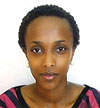According to the Global Hunger Index (2012), Rwanda ranks second hungriest after Burundi in the East African region. That is terrifying and yet, unfortunately, not surprising. Given the trends in population growth, the rapidly-changing climatic conditions and poverty levels, it is natural that some of our top issues include food security and malnutrition.


According to the Global Hunger Index (2012), Rwanda ranks second hungriest after Burundi in the East African region. That is terrifying and yet, unfortunately, not surprising. Given the trends in population growth, the rapidly-changing climatic conditions and poverty levels, it is natural that some of our top issues include food security and malnutrition.As of 2012, approximately one-fifths of Rwandan households would be considered food insecure: albeit a sweeping improvement from the situation in the early 2000s, there is still so much left to do to bridge the malnutrition gap.If it is true that over 80 per cent of Rwandans rely on agricultural activity for sustenance, this is dumbfounding. In fact, statistics seem to indicate that it is households not involved in agriculture that are relatively food secure.Food security is such a broad issue: my interest in food security has less to do with how much food households have at a given time, and more to do with the measure of pliability to future food supply disruptions due to a number of risk factors. Our reliance on seasons for food supply, and given the volume of food imported from neighbouring nations (even though food production has increased over the years), we need a qualitative and quantitative understanding of where we stand in terms of self-sufficiency and external dependency if we intend to tackle this issue.It is an all-too-familiar vicious circle: it is difficult to tackle poverty without battling malnutrition and insufficient food supply, and yet poverty makes access to nutritional food all year round relatively impossible. How is it that the regions that produce this country’s food, demonstrate the highest rates of child malnutrition, and even poverty?The fact that, tied to this issue is the fact that Rwanda is a water scarce country with limited land resources (due to high population density), paints an even grimmer picture.Existing and new efforts need to drive productivity: solutions to reduce post-harvest losses, improvement of soil fertility management, stimulation of trade and encouraging best farming practices that utilize science and technology, are only some pieces of the puzzle.This is not breaking news. Agricultural entrepreneurship ventures in Rwanda are increasing n-fold every day, agricultural research institutions and grants continue to sprout countrywide and various supportive initiatives continue to be undertaken by responsible government institutions.I am certainly no expert in this field but maybe one gap that is yet to be filled is the detachments in the agricultural ecosphere. The lack of synergy between teaching/research institutions, agricultural practitioners and market players translates into isolated efforts that don’t yield throughput in quantity and quality of produce.For example, we have no choice but to boost research and adoption of agricultural science (and technology) in order to meet the population’s demands, as traditional methods continue to fall short. Using these scientific methods will provide the opportunity to save colossal amounts of money used for imported pesticides and fertilisers; using science will enable us to address disease and pest prevention, increase the shelf-life of perishable fruits and enhance nutritional content of food.In line with these scientific programmes should be building of community programmes (tied to scientific institutions) that focus on capacity building of farmers and addressing issues related to the lack of access to finance (through microfinance tools, as one example). ICT tele-centres are a resource that could be maximised through provision of community online training courses.Lastly, bridging the gender balance in agricultural production at all stages of the food value chain is paramount. Analysts argue that if women had the same agricultural productive resources as men, they would boost yields by up to 30 per cent. This brings to light issues regarding land rights and inheritance, availability of social amenities and division of labour within rural households; community programmes provide the opportunity for sensitisation on these matters.I sincerely hope that in a number of years, Rwanda shall slide down the ranks of the Global Hunger Index, and position itself as a regional food basket – we cannot settle for the label of a hungry nation. The writer is a social analyst based in Kigali.


